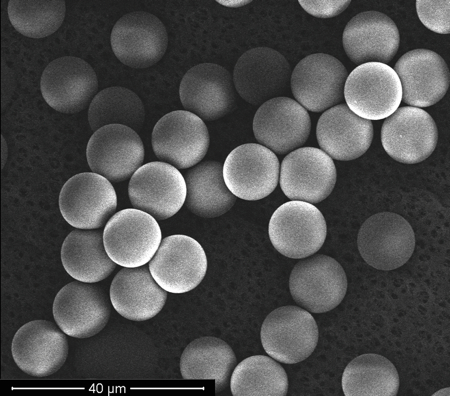Microencapsulation is one of the most interesting areas in modern pharmaceutical technology. It is a complex, interdisciplinary field requiring specialist knowledge of polymer science and familiarity with emulsion technology. It includes the process in which the active pharmaceutical ingredient is trapped in small microparticles. Due to its complexity, micro-encapsulation is extensively studied inside major pharmaceutical companies, universities and research institutes.
Polymeric drug delivery devices are focused on the encapsulation of large molecules including peptides, proteins and DNA/RNA for potential use as vaccines and as long-acting release drug formulations. Moreover, encapsulation is used for controlling the release of poorly soluble compounds. Demand for the process has led to the creation of advanced emulsion solvent evaporation/extraction based micro-encapsulation technologies.
The process of microencapsulation addresses complex modern drug delivery issues. For example, EmulTech and Aesica Pharmaceuticals have developed, and put to use in the formulation of drugs for clinical trials, a microfluidic process that creates a sterile microparticulate suspension where particle size is uniform and reproducible. This novel emulsion technology for micro-encapsulation, ET4ME, is usable in the formulation of multiple APIs, from small molecules right through to complex biomolecules, with high levels of batch consistency and reproducibility upon scale-up. By utilising a closed system, sterile formulations can be achieved, coupled with resistance to oxidative degradation. Aesica has completed successful aseptic process simulation trials using the ET4ME process, thus demonstrating the technology’s potential for sterile injectable product formulation.

Robin de Bruijn (left), Chief Technology Officer, and Fränk de Jong (right) Chief Executive Officer, EmulTech
The business model that is bringing such emulsion technology to life involves contract development companies like EmulTech and Aesica pooling their collective experience and co-operating to advance the use of innovative technologies in product formulation. For example, EmulTech has the capability to test formulations that require small volumes. The company offers a parallel strategy for swift and reproducible scale-up while providing product and process support throughout a product’s development cycle. CMOs of the size of Aesica provide formulation development, analytics and GMP services and expert guidance through the processes of new medicine and material development for Phase I and Phase II clinical trials.
By collaborating, such companies are able to maximise budget effectiveness, minimise experimentation without sacrificing quality levels, and enhance productivity, thereby providing increased value to customers and achieving significantly shorter development times.
Following the in-house pre-clinical formulation and lab-scale process development by EmulTech, Aesica has the capability to further validate the equipment and to formulate products according to cGMP requirements.
Current APIs often exhibit poor solubility and/or a short half-life, requiring novel approaches such as sustained release to achieve acceptable bioavailability. Injectable biodegradable and biocompatible polymer systems that utilise copolymers of lactic and glycolic acid (PLGA) are a promising advanced delivery system for week-to-month controlled release and have been around for decades.
Addressing scale-up challenges
ET4ME type technologies address head on the challenges of large-scale manufacturing/scale-up needs and convoluted production schemes. Polymer microspheres can be formulated with a highly defined size, encapsulating the API in a polymer matrix. The correct matrix sets the release duration (from weeks to months) and perfecting the monodispersed particle size establishes the zero order kinetics of the release.
The system operates under aseptic, closed conditions and eliminates the need for complex work-up steps. Scale-up is achieved by massive parallelisation, ensuring product consistency throughout the pharmaceutical development pipeline.

Figure 2: Operating a multi channel device
Droplet formation in microfluidic devices has always been an interesting approach. EmulTech has made a breakthrough by modelling droplet formation on the cross-intersection of a microfluidic channel structure. Process parameters can be identified by feeding measurable material-specific parameters (e.g. viscosity, interfacial tension) and particle characteristics (e.g. particle size) into the model. When the process parameters are set correctly, each droplet is formed to the same characteristics, ensuring the uniformity of the batch and thus its quality. This way ET4ME translates the trial and error approach of many processes into a quality by design approach.
With this approach, ET4ME overcomes the issues encountered with conventional encapsulation technologies. Indeed, it is because such traditional technologies lack control over particle formation that such broad and uncontrolled particle size distributions are encountered. Without control over this distribution, reproducibility between batches and during scale-up cannot be achieved.
To solve this issue, conventional technologies require costly work-up steps leading to high loss (up to 40%) of the batch. Furthermore, it is challenging to control the final release profile without control over particle size, distribution and therefore the reproducibility.
Because ET4ME designs the microparticles based on material-specific parameters, particles size distributions are highly controlled. Batches are also identical during scale-up. Additionally, it becomes feasible to tune the release profile by changing the polymer, particle size or using blends of particles size distributions.
Besides improving the quality of the product, ET4ME also provides the opportunity to process hard-to-formulate APIs, such as poorly water soluble, highly potent, fragile APIs
Besides improving the quality of the product, ET4ME also provides the opportunity to process hard-to-formulate APIs, such as poorly water soluble, highly potent, fragile APIs. Poorly water soluble APIs can be processed by using the versatility of the technology, for example by changing the phases W/O – O/W, making double emulsions or other approaches.
Highly potent APIs require highly controlled release profiles to remain in what are often narrow therapeutic windows. The control over microparticle formation of this microfluidic technology allows highly potent APIs to be processed.
Fragile APIs are often deactivated as a result of the increase in temperature and shear often resulting from the high-energy input in conventional processes. The microfluidic technology ET4ME requires very little energy to generate the droplets, so there is no temperature increase and only marginal shear.
Scale-up is achieved through process intensifications (more channels per device) and numbering out (cartridges containing multiple devices). Process parameters identified in a single channel set-up can easily be translated to a multichannel set-up to create larger volumes (up to clinical Phase II, depending on the application).
In principle the technology is a highly controlled emulsification technology having various applications in different markets, such as the food industry (taste masking, protection of additives against its surrounding, delivery to the gastrointestinal system), cosmetics (stability enhancement of uniform micro emulsions), chemicals (increased control over reactions), pharmaceutical industry (drug delivery, markers, radiotherapeutics etc.). EmulTech’s prime markets are the inhaled and injectable drug delivery markets, because of the obvious added value ET4ME provides in these markets. The inhaled market requires particles in the range of 1–5µm, and preferably 2–3µm for proper lung deposition. ET4ME, because of its uniformity, is well suited to meet these requirements.

Figure 3: SEM image of 12 micron PLGA particles created with ET4ME (PR)
The injectables market requires sterile suspensions with high syringability. The closed system, combined with the 0.22µm inlet filters, ensures the creation of sterile suspensions. Also the uniform particle size makes the suspension more syringable and thus less painful for the patient. The uniform particle size distribution of ET4ME avoids painful incidents like blocking of needles by particles that are too large. Equally, very small particles that may result in immune response and dose dumping are absent.
Within these fields, EmulTech has already worked on various applications related to intramuscular and subcutaneous sustained release products, as well as harder to research areas such as the back of the eye. Other applications include immune therapies, vaccines, pain treatments, embolising applications, infectious diseases and various inhaled applications.
The main advantages of the technology are:
- Quality by design approach
- Reproducibility between batches and during scale-up
- No end sterilisation as a result of closed system with inlet filters
- Benign process on API, no shear, no heat increase
- Improvements for the product
- Microparticles with a very narrow particles size distribution
- Improved injectability, prevention of dose dumping, zero order release, no burst release
- Broad variety of APIs and carrier materials possible
- New products become feasible, using insoluble APIs or fragile biomolecules
The technology is a highly versatile particle formation technology based on a microfluidic process (Table I). The process enables the particle size, loading and carrier material to be changed so as to create an optimal drug delivery system by offering a high level of control over droplet formation. Size ranges of 1–1000µm (with a distribution of <1%) are possible, with up to 100% encapsulation in perfect spheres with no porosity. The process is applicable to small molecules and biomolecules, is highly reproducible during scale-up and offers reliable batch-to-batch consistency.
| Table 1: Benefits of ET4ME as a particle formation process | |
| Parameter | Benefit |
| Quantifiable | Based on measurable parameters, particle formation is now “measure-and-make.” |
| Compatible | APIs ranging from small molecules to complex biomolecules can be used. |
| Uniform | Particles are individually formed in the same way, leading to uniform size, loading and morphology |
| Consistent | Droplet formation is based on a physical process: fixed process parameters give fixed product characteristics. |
| Scalable | Highly reproducible using mass parallelization. |
| Closed system | Degradation by air/oxygen can be eliminated. |
| Aseptic | Inline filtration in a closed system ensures sterility. |
| Static system | No moving parts, no high temperatures or high shear. Very reliable and stable. |
Parameter optimisation is of critical importance with such emulsion technologies, particularly for criteria such as size, API load and morphology. ET4ME, for example, facilitates the combination of two fluids that cannot be mixed using standard droplet formation techniques. Particles in this purely physical process are produced in separate microchannels, which protect APIs during particle formation. The particles in this versatile process are formed under very low shear conditions and the absence of temperature modifications. With the ability to process any two liquids in a drug delivery system, the optimal excipient and active blend can be achieved, resulting in an optimised product.
Highly potent biologically active ingredients are often easily deactivated and are a challenge to deliver in a pharmaceutical formulation
Highly potent biologically active ingredients are often easily deactivated and are a challenge to deliver in a pharmaceutical formulation. Technologies such as ET4ME preserve the fragile three-dimensional structure of these actives; and the ability to define the optimal composition and release properties, via superior particle formation control, meaning that the challenges that accompany these highly potent active drug substances can be overcome.
Faster development, better products
This type of technology enables products to be developed with better therapeutic effects and improved patient compliance in a cost-efficient and timely manner. By eliminating poor batch-to-batch consistency, variable particle formation and numerous rounds of inaccurate, costly and time-consuming screening, ET4ME allows for more rapid, reliable and efficient prototyping. Such versatile enabling technologies are used for the non-destructive testing of fragile compounds, inhalables, injectables and solid dosage forms.
Many different formulations and multiple parameters can be scanned and tested, facilitating more efficient R&D and accelerating the development, scale-up and commercialisation of highly potent APIs in the product pipeline.
The important development steps made by EmulTech and Aesica resulting in the ability to produce sterile suspensions and reducing the need for end-sterilisation provide the pharmaceutical world with a new, innovative tool in their development programmes.




